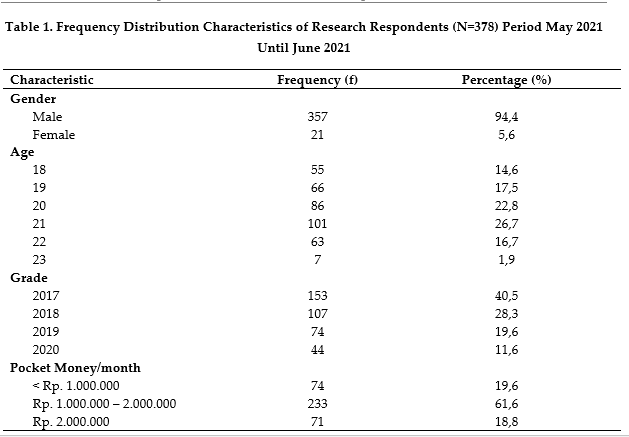Smoking Behavioral Dependence during the COVID-19 Pandemic Among University Student
DOI:
https://doi.org/10.23917/bik.v16i2.2214Keywords:
Behavioral Smoking Dependence, covid-19, studentsAbstract
Smoking, an addictive behaviour, is a health problem that is still found during the COVID-19 pandemic. There are several possibilities that have impacts on smoking behaviour during the COVID-19 pandemic. The aim of this study is to understand the description of smoking addiction during the COVID-19 pandemic towards students at the University. A descriptive quantitative research design was used. This study involved one variable which is smoking behavioral dependence during the COVID-19 pandemic in students at the University. The populations in this study are students who are active smokers (conventional, electric, or shisha) at one of the universities in Indonesia. The sampling technique uses accidental sampling, and it is obtained a sample of 378 students. The instrument in this study uses the GN-SBQ (Glover Nilsson-Smoking Behavioural Questionnaire). The results of the research data are analyzed using descriptive analysis in the percentage frequency distribution. Based on the results of the study, it is found that during the COVID-19 pandemic, most of the respondents experienced smoking dependency behavioral moderate (66.4%), strong (20.9%), and mild (12.7%). The use of cigarettes during the COVID-19 pandemic mostly uses conventional rather than electric and shisha. Based on the characteristics of the respondents, smoking behavioral dependency is dominated by male students, aged 21 years, grade 2017, and had pocket money in the middle economic category. Therefore, this study recommends health services to provide counselling and mentoring services for students, which one of them is the Cognitive Behavioral Therapy (CBT) approach to reduce the level of smoking behavior.
References
Adistie, F., Pahria, T., Prawesti, A., & Dewi Safariah, T. (2015). Factors Supporting Female Student Smoking Behavior. Faktor-Faktor yang Mendukung Perilaku Merokok Mahasiswi. Jurnal Keperawatan ’Aisyiyah, 2, 12. http://jurnalkeperawatan.stikes-aisyiyahbandung.ac.id/file/FanyAdistieDkk_JKA_Vol2_No1_Juni_2015_10.pdf
Ahmed, N., Maqsood, A., Abduljabbar, T., & Vohra, F. (2020). Tobacco smoking a potential risk factor in transmission of COVID-19 infection. Pakistan Journal of Medical Sciences, 36(COVID19-S4), S104–S107. https://doi.org/10.12669/pjms.36.COVID19-S4.2739
Andiarna, F., & Kusumawati, E. (2020). The Effect of Online Learning on Student Academic Stress During the Covid-19 Pandemic. Pengaruh Pembelajaran Daring terhadap Stres Akademik Mahasiswa Selama Pandemi Covid-19. Jurnal Psikologi, 16(2), 139. https://doi.org/10.24014/jp.v16i2.10395
Ardiyanti, P. D., Harzani, S., Rahmah, S. A., & Putri, Z. M. (2020). Overview of Knowledge of Smoking Behavior during the COVID-19 Pandemic among Adolescent Boys in the Greater Jakarta Area in 2020. Gambaran Pengetahuan Perilaku Merokok di Masa Pandemi COVID-19 pada Kalangan Remaja Laki-laki di Wilayah Jabodetabek Tahun 2020. Jurnal Ilmu Kesehatan Indonesia (JIKSI), 1(2), 1–8. https://doi.org/10.57084/jiksi.v1i2.409
Arisona, A., Rahayuwati, L., Prawesti, A., & Agustina, H. S. (2020). Smoking Behavior and the Use of Cigarette Types Among University Student. Journal of Educational and Social Research, 10(5), 211. https://doi.org/10.36941/jesr-2020-0100
Atlas, T. T. (2019). Cigarette Use Globally. The Tobacco Atlas.
Berk, L. E. (2012). Development Through the Lifespan. In Vygotsky’s Educational Theory in Cultural Context. https://doi.org/10.1017/cbo9780511840975.009
Bommelé, J., Hopman, P., Walters, B. H., Geboers, C., Croes, E., Fong, G. T., Quah, A. C. K., & Willemsen, M. (2020). The double-edged relationship between COVID-19 stress and smoking: Implications for smoking cessation. Tobacco Induced Diseases, 18(April), 1–5. https://doi.org/10.18332/TID/125580
Chen-Sankey, J. C., Broun, A., Duarte, D. A., Ajith, A., Jewett, B., Smiley, S. L., Mead-Morse, E. L., Guy, M. C., & Choi, K. (2020). Exploring changes in cigar smoking patterns and motivations to quit cigars among black young adults in the time of COVID-19. Addictive Behaviors Reports, 12, 100317. https://doi.org/10.1016/j.abrep.2020.100317
Chen, D. (2020). The psychosocial impact of the COVID-19 pandemic on changes in smoking behavior: Evidence from a nationwide survey in the UK. Tobacco Prevention & Cessation, 6(October), 1–5. https://doi.org/10.18332/tpc/126976
Chinwong, D., Mookmanee, N., Chongpornchai, J., & Chinwong, S. (2018). A Comparison of Gender Differences in Smoking Behaviors, Intention to Quit, and Nicotine Dependence among Thai University Students. Journal of Addiction, 2018, 1–8. https://doi.org/10.1155/2018/8081670
Fauzi, A., Punia, I. N., & Kamajaya, G. (2017). The Culture of Hangouts for Young People in Cafes (Review of the Lifestyle of Young People in Denpasar City). Budaya Nongkrong Anak Muda di Kafe (Tinjauan Gaya Hidup Anak Muda di Kota Denpasar). Jurnal Ilmiah Sosiologi (SOROT), 3(5), 40–47. https://ojs.unud.ac.id/index.php/sorot/article/view/29665
Gaiha, S. M., Cheng, J., & Halpern-Felsher, B. (2020). Association Between Youth Smoking, Electronic Cigarette Use, and COVID-19. Journal of Adolescent Health, 67(4), 519–523. https://doi.org/10.1016/j.jadohealth.2020.07.002
Glover, E. D., Nilsson, F., Westin, Å., Glover, P. N., Laflin, M. T., & Persson, B. (2005). Developmental history of the Glover-Nilsson smoking behavioral questionnaire. American Journal of Health Behavior, 29(5), 443–455. https://doi.org/10.5993/AJHB.29.5.7
Gülsen, A., Yigitbas, B. A., Uslu, B., Drömann, D., & Kilinc, O. (2020). The Effect of Smoking on COVID-19 Symptom Severity: Systematic Review and Meta-Analysis. Pulmonary Medicine, 2020. https://doi.org/10.1155/2020/7590207
Heo, J., Oh, J., Subramanian, S. V., & Kawachi, I. (2014). Household and school-level influences on smoking behavior among Korean adolescents: A multilevel analysis. PLoS ONE, 9(6). https://doi.org/10.1371/journal.pone.0098683
Ho, L. L. K., Li, W. H. C., Cheung, A. T., Xia, W., Wang, M. P., Cheung, D. Y. T., & Lam, T. H. (2020). Impact of COVID-19 on the hong kong youth quitline service and quitting behaviors of its users. International Journal of Environmental Research and Public Health, 17(22), 1–8. https://doi.org/10.3390/ijerph17228397
IAKMI, T. (2020). Atlas Tembakau Indonesia Tahun 2020 (K. Soewarso, H. Siregar, M. A. P. N. Kusuma, L. Hikmah, R. Fauzi, & A. Antojo (eds.)). Tobacco Control Support Center-Ikatan Ahli Kesehatan Masyarakat Indonesia (TCSC-IAKMI). http://www.tcsc-indonesia.org/wp-content/uploads/2020/06/Atlas-Tembakau-Indonesia-2020.pdf
Jawad, M., Charide, R., Waziry, R., Darzi, A., Ballout, R. A., & Akl, E. A. (2018). The prevalence and trends of waterpipe tobacco smoking: A systematic review. PLoS ONE, 13(2), 1–20. https://doi.org/10.1371/journal.pone.0192191
Juranic, B., Miksic, S., Rakosec, Z., & Vuletic, S. (2018). Smoking Habit and Nicotine Effects. IntechOpen, 32, 49–60. https://doi.org/10.5772/intechopen.77390
Kale, D., Herbec, A., Perski, O., Jackson, S. E., Brown, J., & Shahab, L. (2021). Associations between vaping and Covid-19: Cross-sectional findings from the HEBECO study. Drug and Alcohol Dependence, 108590. https://doi.org/https://doi.org/10.1016/j.drugalcdep.2021.108590
Khader, Y. S., & Alsadi, A. A. (2008). Smoking habits among university students in Jordan: prevalence and associated factors. Eastern Mediterranean Health Journal, 14(4), 897–904. https://www.researchgate.net/publication/23936541_Smoking_habits_among_university_students_in_Jordan_prevalence_and_associated_factors_East_Mediterr_Health_J
Khairani, W. (2019). The Effect of Cognitive Behavior Therapy on Smoking Behavior. Pengaruh Therapi Kognitif Behavior Terhadap Perilaku Merokok. Jurnal Ilmiah Universitas Batanghari Jambi, 19(2), 357. https://doi.org/10.33087/jiubj.v19i2.679
Liem, A. (2016). The Effect of Nicotine on Brain Activity and Function and Its Relationship with Psychological Disorders in Cigarette Addicts. Pengaruh Nikotin Terhadap Aktivitas Dan Fungsi Otak Serta Hubungannya Dengan Gangguan Psikologis Pada Pecandu Rokok. Buletin Psikologi, 18(2), 37–50. https://doi.org/10.22146/bpsi.11536
Naresawari, A. D., Wijayanti, E., Oktaviani, F. I., & Santoso, A. P. A. (2020). Analysis of cigarette users during the COVID-19 pandemic in Nogosari District. Analisis pengguna rokok di masa pandemi COVID-19 di Kecamatan Nogosari. Prosiding HUBISINTEK, 1, 72–76.
Nerín, I., Crucelaegui, A., Novella, P., Beamonte, A., Sobradiel, N., Bernal, V., & Gargallo, P. (2005). Assessment of Behavioral Dependence With the Glover-Nilsson Test in Smoking Cessation Treatment. Archivos de Bronconeumología ((English Edition)), 41(9), 493–498. https://doi.org/10.1016/s1579-2129(06)60269-3
Perelman, J., Alves, J., Pfoertner, T., Moor, I., Federico, B., Kuipers, M., Richte, M., RImpela, A., Kunst, A., & Lorant, V. (2015). Pocket money and smoking behaviors among adolescents: evidence from a study on 6 European cities. European Journal of Public Health, 25(3). https://doi.org/10.1093/eurpub/ckv173.071
Ruhyat, U. (2021). Smoking Behavior during Covid 19. Perilaku Merokok di Masa Covid 19. Jurnal Sehat Masada Volume XV Nomor 1, XV. https://doi.org/10.38037/jsm.v15i1.178
Sawitri, A. R., & Widiasavitri, P. N. (2021). Coping strategies for students who are preparing their thesis in the midst of the COVID-19 pandemic. Strategi coping mahasiswa yang sedang menyusun skripsi di tengah pandemi COVID-19. Jurnal Psikologi Udayana, 8(1), 78–85. https://doi.org/10.24843/JPU.2021.v08.i01.p08
Siddiqi, K., Siddiqui, F., Khan, A., Ansaari, S., Kanaan, M., Khokhar, M., Islam, Z., Mishu, M. P., & Bauld, L. (2020). The Impact of COVID-19 on Smoking Patterns in Pakistan: Findings From a Longitudinal Survey of Smokers. Nicotine & Tobacco Research, 1–5. https://doi.org/10.1093/ntr/ntaa207
Sifat, A. E., Nozohouri, S., Villalba, H., Vaidya, B., & Abbruscato, T. J. (2020). The Role of Smoking and Nicotine in the Transmission and Pathogenesis of COVID-19. Journal of Pharmacology and Experimental Therapeutics, JPET-MR-2020-000170. https://doi.org/10.1124/jpet.120.000170
Simonavicius, E., McNeill, A., Arnott, D., & Brose, L. S. (2017). What factors are associated with current smokers using or stopping e-cigarette use? Drug and Alcohol Dependence, 173, 139–143. https://doi.org/10.1016/j.drugalcdep.2017.01.002
Stop-tobacco.ch. (2021). The Different Types of Dependency. Stop-Tobacco.Ch. https://www.stop-tobacco.ch/en/coping-with-withdrawal-symptoms-2/dependencies-different-types
Suhányi, L., Gavurová, B., Ivanková, V., & Rigelský, M. (2019). Smoking behaviour of university students: A descriptive study. Adiktologie, 20(1–2), 57–63. https://doi.org/10.35198/01-2020-001-0009
Susiladiharti, & Gunawan, U. P. (2020). Application of Cognitive Behavior Therapy to Children in the Kebon Waru Village, Bandung City. Penerapan Cognitive Behavior Therapy pada Anak di Kelurahan Kebon Waru Kota Bandung. Ilmu Kesehjahteraan Sosial HUMANITAS, 2(1), 283.
West, R., & Gossop, M. (1994). Overview: A comparison of withdrawal symptoms from different drug classes. Addiction, 89(11), 1483–1489. https://doi.org/10.1111/j.1360-0443.1994.tb03747.x
WHO. (2020). Coronavirus disease (COVID-2019) situation reports. World Health Organisation.

Downloads
Submitted
Accepted
Published
Versions
- 2023-09-01 (2)
- 2023-08-31 (1)
How to Cite
Issue
Section
License
Copyright (c) 2023 Vania Dwi Ramadhani, Laili Rahayuwaty, Mamat Lukman

This work is licensed under a Creative Commons Attribution 4.0 International License.


















